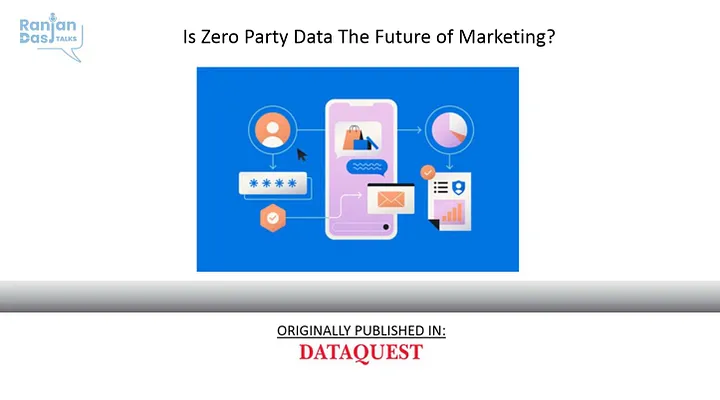
Blog
Is Zero Party Data The Future Of Marketing?
Zero-party data is the newest form of data collection, the information that a client voluntarily and knowingly gives to a business.

Ranjan Das
· Posted: 2022-07-27
Posted: 2022-07-27

It’s becoming increasingly important, but it can be confusing to understand what it is and how it works. If you’re wondering what zero-party data is and why it matters, read on! We’ll cover everything from how to collect your own zero-party data to the benefits of doing so.
What is zero-party data- Zero-party data is the newest form of data collection, the information that a client voluntarily and knowingly gives to a business. Personal situations, purchase intentions, preference center data, and how a customer wants to be remembered by the business, can all be included. The phrase was initially used by Forrester Research, popular since then, businesses all around the world have now realized how crucial it is to acquire zero-party data.
How does this differ from other kinds of digital tracking? Well let’s look at each type:
First-Party Data: When someone provides personal details like name, address, email, etc. — this is what we call first-party data because they volunteered to provide their details willingly.
Second-Party Data: The data is obtained from a dependable partner when you typically know the person and are well-aware of the accuracy and quality of the data. Additionally, you are aware that the information is pertinent because it is provided by a business partner who benefits both of you.
Third-Party Data: Companies buy lists full of people’s names, phone numbers, addresses, social media profiles, etc. These lists are often sold by marketers who’ve collected them through magazine surveys. These third-party marketers generally have no idea whether any given person will want whatever product/service is offered. Therefore, there’s no guarantee of this kind of data.
Ways to collect zero-party data- Zero-party data can be collected in a variety of ways, including websites and apps, mobile devices, sensors, and other connected devices. For example:
When you are collecting zero-party data, it’s important to be as targeted as possible. That means creating targeted pop-ups or surveys that will help you gather information from the people who are most likely to be interested in your products or services.
You can also host a contest with a landing page form, allowing customers to enter and win a prize while they share their data with you. This can be done through social media or email marketing. However, you must make sure that the award is something that appeals to your target audience!
Benefits of collecting zero-party data- Collecting data is a critical part of any business’s efforts to understand its customers. It allows you to have a better understanding of what your customers are looking for, what they need, and how to improve your product or service.
Here is an extensive list of benefits that come from collecting data:
-Data quality and accuracy. If the data you collect isn’t accurate or reliable, it won’t be helpful for making decisions about your business’s future.
-Relevance. Getting the correct information at the right time can save time and money by enabling you to focus on what matters the most — your customers.
-Cost-efficiency. Collecting data is more cost-effective than relying on guesswork and assumptions about what customers want or need.
Is Zero-Party Data the Future of Marketing? — The concept of gathering customers’ interests and using this information to deliver relevant engagements is central to modern marketing. No matter what your business model is, you are likely to use data to optimize it for success. If you are not using the data, you are most likely to waste money and time. Think about it: The more data you have on your customers, the more valuable it is to you. You can use that data to make sure that you make your products better and keep them at the top of their game.
With the advent of zero-party data, marketers have been allowed to bring transparency and value-added relationships into their digital interactions. Other types of data collection are frequently linked with browser and operating system restrictions, such as changes to third-party cookies. Marketers can now use zero-party data to engage with their audiences in more authentic ways.
Recent events, such as Google’s initiative to phase out tracking cookies by 2023, have only confirmed what we have known for years: third-party data is dying. The iOS 14.5 and 15 updates from Apple were the final nails in the coffin.
Marketers no longer rely on third parties to collect and process their data. Instead, they accumulate it themselves or use tools that allow for the collection and processing of data directly from user devices. It offers marketers many advantages over the current system.
For example, analysts have long been able to track how people engage with brands online by analyzing their browsing or search history. However, these methods only provide limited insight into individual users’ behavior — and even then, only if you are able to access their specific accounts. Zero-party data allows for a much more detailed analysis of individual users’ behaviors and attitudes, which can help businesses understand what motivates consumers and how they respond when presented with certain messages or advertisements.
Conclusion
While zero-party data collection is still in its infancy, it’s clear that it has many advantages over other types of data. Zero party data is more accurate as the respondent (customer) is filling it in him/herself. Additionally, it demonstrates any preferences a consumer may have for how they want to be reached. You always have control over its cost because it results from your own response system and offers, making it generally the most economical option. And to top it all off, zero party data is compliant for all purposes, and you run no risk as long as it’s not misused.
You can create more targeted and effective campaigns with no third-party data. Brands can create personalised campaigns in the age of ecommerce. More robust consumer profiles will aid in inventory management, lowering the cost per customer acquisition. Though zero-party data is not new, its importance has grown as everyone now seeks low cost and high accuracy. With the availability of new tools for marketers to tap into this type of information and with the industry willing to adopt the practice, we can expect to see even more innovations in how brands use this valuable resource.
Source- https://www.dqindia.com/future-prospects-for-zero-party-data/
Marketing is everything, products are
woven around it.